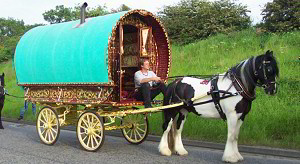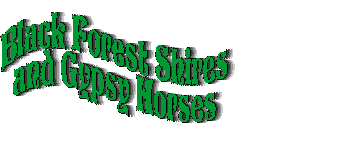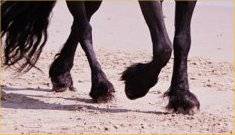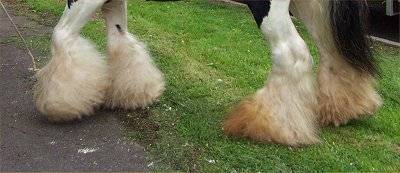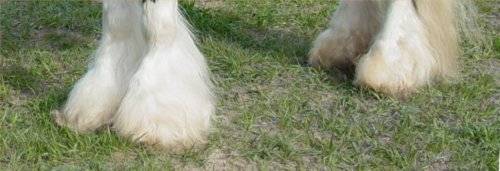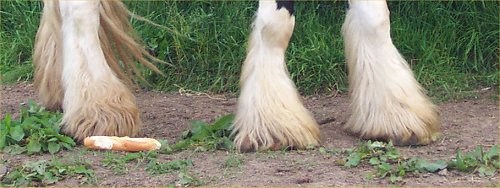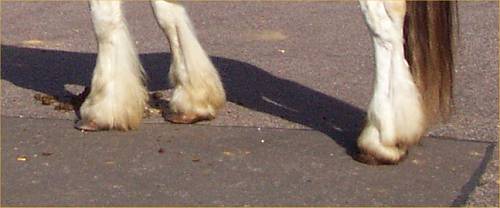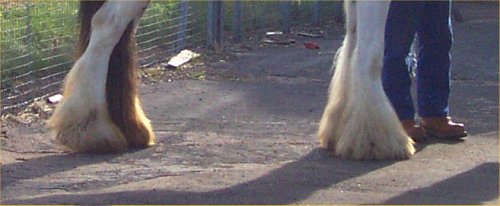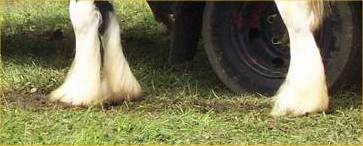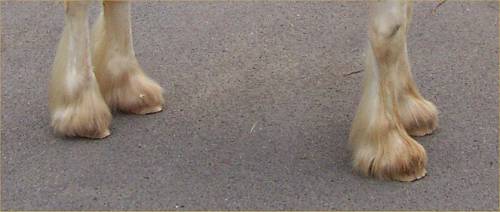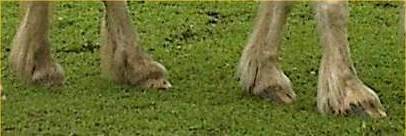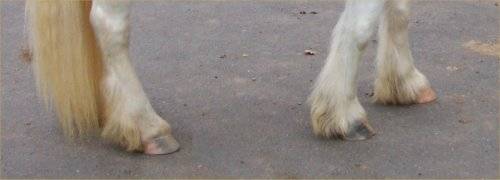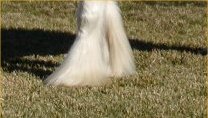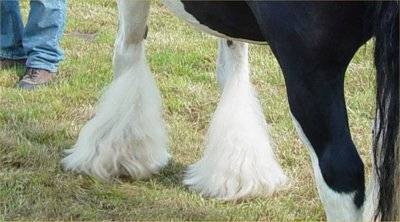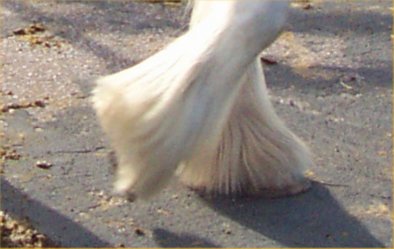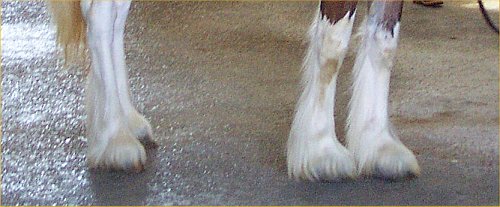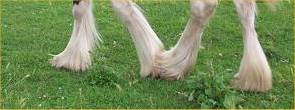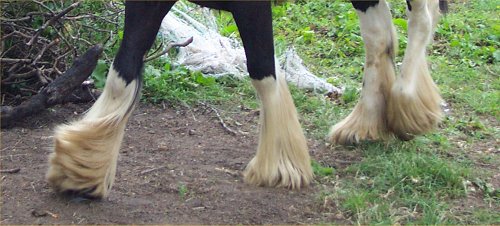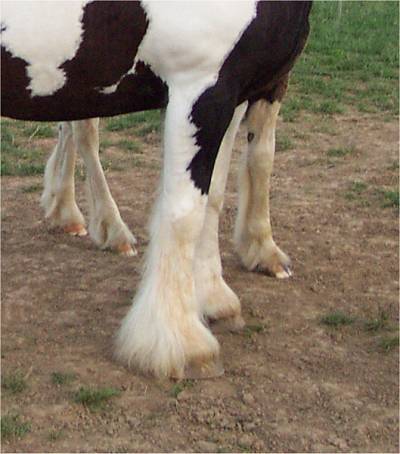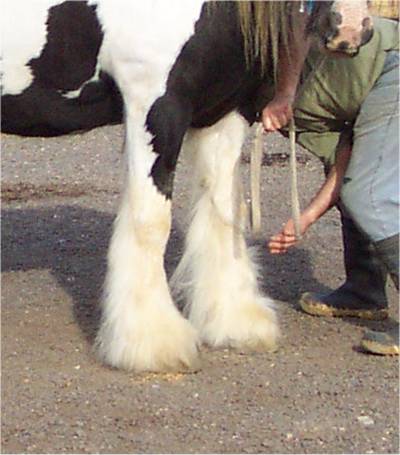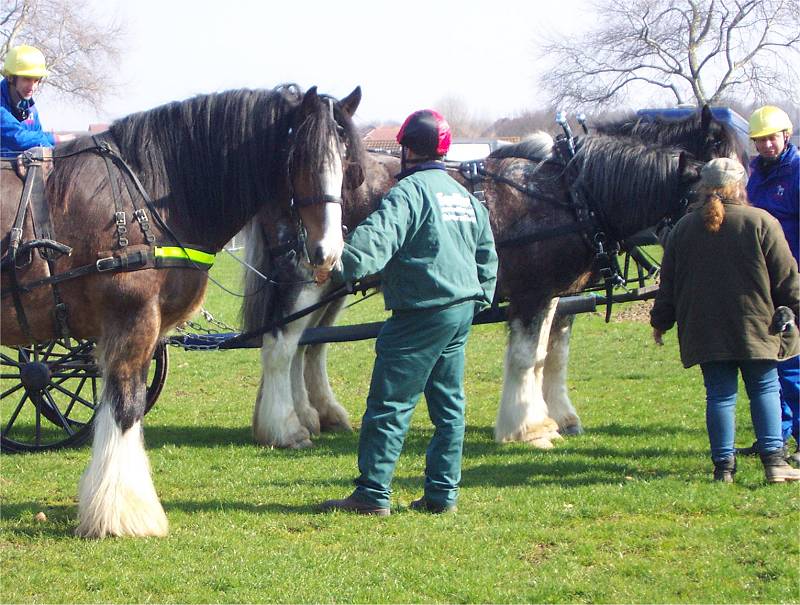|
|
|
Feather
Many people seem to be very
confused about what is considered "feathered", and what is considered
"well feathered". We've seen many ads for these horses on the web that
describe
the horse as "heavily feathered", or that it has "tons of feather" and
other similar claims. Yet, when we look at the horse, we can
only sigh. Yes, it
may be a good deal of feather compared to a light horse, or a Belgian
draft, or even a Friesian, but that is NOT acceptable feathering for a
gypsy horse. Below are some examples and comments on what is, and what
is not, good feathering for a gypsy horse.
Rule to live
by in gypsy horses:
EXAMPLES
Stallions:
Stallions need to have feather in
order to be considered worth breeding in the gypsy community. Not
just feather, but TONS of feather.
Figure 1.) This is the feather of one of the top stallions (7
years old) in England. This guy has thicker feather than some of
the silky-feathered stallions. The heaviest-feathered stallions
are usually this type of feather. The feather MUST start on the
front of the cannon bone at the knee for a colt to even be considered
for growing up for stallion potential.
Figure 2.) Feather of a 6 year old stallion. Not coarse,
not silky, somewhere in between.
Figure 3.) Feather of a 5 year old well bred gypsy stallion.
Although it's not clean or brushed out, this is the straight, silky
feather that is so in demand among gypsy breeders. This is about
as much hair as you will see on a straight-feathered stallion. If
the hair is in good shape (not burned out or anything), and you can see
hoof, you don't have a good stallion. NOT ALL horses will grow
feather like this.
Figure 4.) Feather of a 3 year old stallion. In
stallions, this is about the least amount of feather that would be
acceptable to even the poorest of gypsy breeders. This is
mid-grade feather, not straight, but not curly either. By 3 years
old a stallion has pretty much all the feather he will ever have (unless
it's burned out or shaved or something).
Anyone who tells you different that this is trying to sell you an
inferior horse!
Figure 5.) Feather of an 8 year old stallion. This is an
unacceptable amount of feather in a stallion over 6 months old. No
proper gypsy breeder would even consider this horse for breeding under
any circumstance. This horse is a cross between a feathered gypsy
horse and a non-feathered horse, but was sold as a full gypsy stallion.
This is a good example of a "half-legger". Compare
this full grown stallion to the 2 year old colt below (figure 8), you
will definitely see the difference! I was lucky enough to see
these two horses together at one time, and I had doubts as to whether
they were even of the same breed.
COLTS:
Figure 6.) Feather of a 2 year old colt. Any 2 year old
that only has this much feather will be gelded and sold on, never
to be bred. This is the amount I would expect to see on a weanling colt.
On a yearling colt it would be marginal, but on a 2 year old, it's
unacceptable.
Figure 7.) This 5 MONTH old colt has as much hair in front
(this is where the difference is at this age, the front of the hoof) as
the 2 year old colt above. Don't make the mistake of looking at
the back of the leg to determine how much feather a horse has!
Some Belgians and Friesians have hair in the back that goes down to the
ground, but still none in the front. Remember, that's not a
feathered horse.
Figure 8.) Feather of a 2 year old colt with excellent
feathering, a prized colt from one of the best known gypsy breeders.
You can see there is a Profound difference between the 2 year old colts
in figures 6 and 8!
Figure 9.) A yearling colt with lots of great, straight, silky
feather. Grade = excellent, you will have a hard time finding
more in a yearling.
Figure 10.) A yearling colt with a nice amount of feather.
Grade = good, has good potential.
Figure 11.) A yearling colt with an average amount of
feather. Grade = acceptable. The length is almost at the
ground already in front, but it is not as full as some of the other
colts. Any less on a yearling is not acceptable in a potential
breeding stallion. This yearling still has a good amount more than
the 2 year old in figure 6!
"Flow Chart" Top class: A young colt like the five month old in the figure 7 becomes a yearling like figure 9, which becomes a two year old like figure 8, which becomes a stallion like figure 3. Middle class: A colt like the yearling in figure 10 becomes a stallion like the three year old in figure 4. These are the types that the poorer, but still proud gypsy breeders will breed. Not bad, but not the best. Not even in the same class: In contrast: A two year old like figure 6 will turn into a stallion like figure 5. Don't let unscrupulous sellers try to tell you that they will eventually get tons of feather like the horses you see in the calendar pictures. If they don't start out with feather, they will never have it.
Mares:
The heaviest mare won't
have as much feather as the heaviest stallion, but a good mare will have
more feather than an average stallion. The heaviest (this means
feather) horses around will be stallions, but the top mares anywhere
will be close in feather amount. Those mares are few and far
between, but that shouldn't be an excuse to take an unacceptably
feathered mare and try to breed something good with her. It just
won't work, which has been proven over generations by our gypsy
breeders. We don't need to reinvent the wheel with these horses,
all the hard work has been done for us by the gypsies. Put your
money into buying what they consider to be a good horse, and you will
never be disappointed, either personally or financially. Mares are
every bit as important as stallions (some say more important) in
breeding, so don't make the common mistake of getting a decent stallion
and trying to fix inferior mares with him. That trick never works. Foals:
It's easiest to get a good idea of hair in a foal by waiting until he is
close to a year old. Another good way to get some sort of idea is
by looking at the parents. This does not mean that the two
heaviest parents will always produce the heaviest foal, but I can
guarantee that two unacceptably feathered parents will NEVER produce an
acceptably feathered foal. If you breed a mare like this or this to a stallion like the one in figure 5, you will get a foal like the two year old pictured in figure 6, who will never have more hair than his parents. If you breed a mare like Mares 1-2, to a great stallion, you will get somewhat more hair, but still not as much hair as you, and the market, want. Remember, hair is accumulative and recessive. If you want lots of feather, you have to breed from lots of feather ON BOTH SIDES. Even this does not always give you incredibly heavily feathered foals, but it's the only way to even have a chance. Breed the most feather you can afford to the most feather you can afford, and you have a pretty good chance of producing what the educated buyer wants.
Figure - Mare 3 - Feather of a three year old, larger mare.
This is about the least amount of feather that is at all acceptable in a
mare (and only if she is the larger sized, shire-ish type of mare).
It still covers the front of her hooves, so it is "feather" by
definition, but it's not good feather. Put to a greatly feathered
stallion, she has a good chance of producing an acceptably feathered
foal. A mare with this amount of feather shouldn't be too
expensive to buy. She still has much more than the mares in
figures 1 and 2 (and those mares are both mares who have been imported
into the US as pure gypsy horse mares!!).
Figure - Mare 4 - Three year old mare - unacceptable. It
doesn't matter what kind of bloodlines a mare like this is *supposed* to
have - one like this is considered "worthless" to any true gypsy breeder,
even the poor ones. We have NEVER found a mare like this one in a
broodmare field of a true gypsy breeder, but we have found hundreds of
horses like her in the horse dealers fields.
Figure - Mare 5 - By contrast, another 3 year old mare. This
gal has the right kind of silky feather starting up at the knee in front
like it should. It would be fuller and silkier if it were clean, but you
can get the general idea. BIG difference in the two mares!
Unfortunately for the buyer of the above mare, the prices on the two
mares were similar! Beware of unscrupulous sellers that will tell
you that hair like in figure 'Mare 4' is acceptable!
Figure - Mare 6 - Four old mare. Grade - Very good. Nice
and silky, and plenty of it coming from the knee IN FRONT, just as it
should. This is a very high-class mare in the hair department.
Figure - Mare 7 - Top of the line six year old mare. Grade
- Excellent, as good as it gets in a mare. This is the kind of
mare you need to produce foals like in figure 9. This is the kind
of mare that has more hair than most stallions. If she were a
stallion, she would be like the stallion in figure 1.
Figure - Mare 8 - Two year old filly. This filly will turn
into a mare like figures 6 or even 7. She has wonderful feather
for a two year old.
This picture shows that it's not just a problem in gypsy horses! The shire on the left has been kept up nice and dry for the winter, but the ones to the right (it's a team) have CLASSIC bog burn going on. It looks shaved in the front, but it's not. It's just burned off. It will come back, and be full and beautiful again, but that will take a bit of time. This picture was taken in March, just after a long, wet winter in England, so it's not an uncommon sight, unfortunately. Just remember, it's temporary, the horses will look fabulous again in a few months.
|
|
|
||||||||||||||
All About Feather
How to evaluate feather in the Gypsy Horse
Original article by Christine Bartko
|
|
|||||
|
|
|||||
|
|
